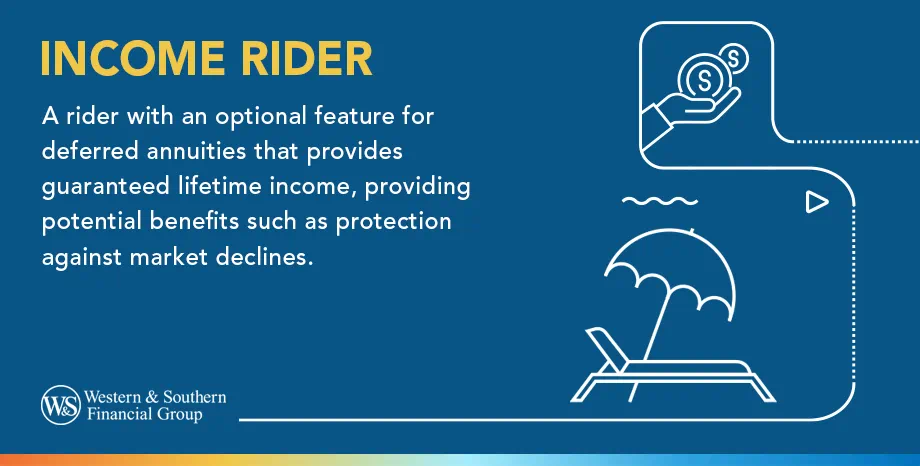

Table of Contents
Key Takeaways
- Income riders offer guaranteed lifetime income through deferred annuities.
- They may also provide a growing benefit base that determines future income.
- Riders offer protection against market declines and flexibility in withdrawals.
- They're suitable when long-term income is needed and lump sum withdrawals aren't a priority.
- Careful selection of a strong annuity provider is crucial for a secure retirement strategy.
Guaranteed lifetime income is not unusual for those who receive annuities. But annuities with an income rider can allow a degree of flexibility while providing a lifetime income stream. With these annuity riders, you don't need to annuitize (or irrevocably hand over your assets to an insurance company).
Instead, you can start receiving guaranteed income payments while keeping the option to take lump sum withdrawals if needed. Annuity riders can also help insulate you from market volatility so your income won't necessarily diminish as a result of stock market losses — though this benefit comes with additional fees, charges and withdrawal limitations that may end up exceeding its value.
Income Rider Defined
An income rider is an optional feature that you can use with deferred annuities. The rider provides guaranteed income for the remainder of your life, starting at a certain age (as early as 60, in some cases). Riders may also provide a growing benefit base that your insurance company uses to calculate your future income. But guaranteed lifetime income isn't free, so expect to pay an annual charge if you choose to use an income rider. You can read through your annuity disclosures carefully to see how this cost is calculated, or (preferably) you can consult a registered representative.
Although your benefit base typically starts with your original investment, it is actually a hypothetical account value your insurance company tracks over time. Depending on your contract, your income might be based on your actual account value or your hypothetical account value — whichever is greater. Income riders usually pay a percentage of your benefit base annually. For example, if your benefit base is $100,000 and your rider pays 5 percent, it would pay $5,000 per year. Even if your account value falls to zero, income payments continue, assuming you meet all of your annuity provider's requirements and restrictions.
Some income riders automatically increase your benefit base, and they may even add growth on top of investment gains, if any, in your annuity (for a fee). This feature can help you secure a higher income at pace with inflation while you wait for payments to start. For example, assume you invest $100,000 in an annuity that grows your benefit base at 7 percent per year. After the first year, your benefit base becomes $107,000, regardless of how your actual account value performs, though you can only access the benefit base value through withdrawals in accordance with the terms of the rider. Growth often continues for up to 10 years, although other growth arrangements may be available.
How Does an Income Rider Affect Distributions?
You can generally take money out of a deferred annuity at any time, though withdrawals prior to age 59 1/2 will incur a 10 percent penalty from the IRS. But your benefit base (or hypothetical account value) is not available for a lump sum distribution. You can withdraw your actual account value, reflecting any market gains or losses, but your benefit base is only used for calculating systematic income from your annuity provider. Also, it's critical to evaluate taxes and any surrender charges that may result from withdrawals.
Unlike buying an immediate annuity, taking income from an annuity rider is not an irrevocable decision. You can withdraw your guaranteed amount, or more or less than that amount, each year. However, taking more than your guaranteed amount may reduce your benefit base and the future withdrawals available to you, so you may want to ask your financial representative (or registered representative) for details before doing so.
When Could an Income Rider Make Sense?
Income riders may not be right for everybody's financial plan, but they may help provide a solution in certain situations.
If you want to guarantee a minimum amount of income and buy insurance against steep market declines, you may want to consider an income rider. At the same time, those riders can allow you to keep your options open and take lump sum withdrawals when the unexpected happens.
Income riders tend to work best when you don't need income for at least several years. They're generally only available on deferred annuities, giving you the opportunity to grow your assets (or use the insurance company's guaranteed benefit base increase) over time. If you want to start your lifetime income stream now, immediate annuities and other alternatives may be a better fit.
Income riders are designed to pay benefits over time — as annual (or monthly) income. If you intend to take large lump sums from your annuity's account value, an annuity income rider might not be the right fit. That said, if your total annual withdrawals are smaller than your guaranteed income amount, the strategy may work.
If you want to provide some lifetime income for both yourself and your spouse, that option is available on select insurance contracts.
Ideally, an income rider will be with you for the rest of your life. As a result, it's essential to choose an annuity provider with the financial strength to last at least as long as you do. Knowing you've made the right decision for your financial needs can then help you kick back (or not!) and enjoy the retirement you've worked hard to achieve.












